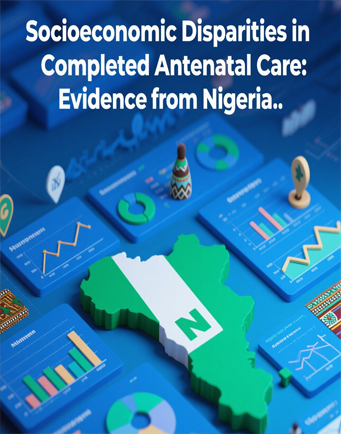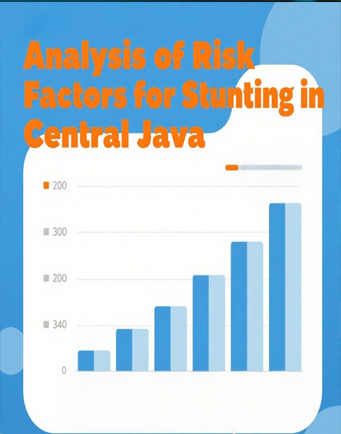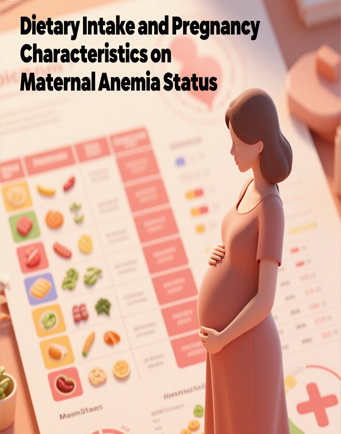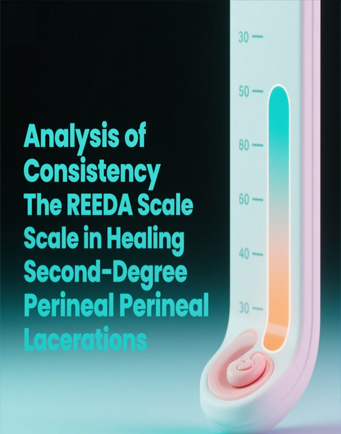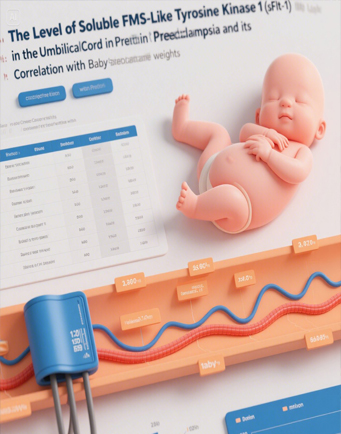Type of Occupation and Smoking Behavior: A Multinomial Analysis of Global Adults Tobacco Survey (GATS) Indonesia
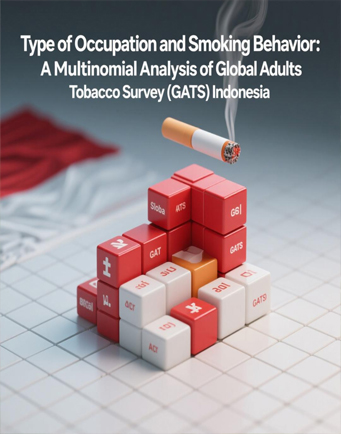
Downloads
Smoking remains a major public health problem in Indonesia, with occupation playing a key role in shaping smoking behavior. This study investigated how occupational type affects smoking behavior among Indonesian adults. This study was using data from the 2021 Global Adult Tobacco Survey (GATS), which included 9,155 respondents. The dependent variable was smoking behavior (daily smoker, non-daily smoker, or never smoker), and the main independent variable was occupational type. Control variables included age, gender, education level, and place of residence. Data analysis involved descriptive statistics, chi-square test, ANOVA, and multinomial logistic regression. The results showed that 25.47% of adults were daily smokers, 5.95% were non-daily smokers, and 68.57% were never smokers. Most participants were unemployed (47.67%), indoors workers (15.03%), outdoors (32.90%), or in both settings (4.40%). Bivariate analysis revealed significant associations between smoking behavior and type of occupation, gender, education, place of residence, and age. Daily smoking was more common among men, individuals with lower education, rural residents, and outdoor workers. Multivariate analysis indicated that outdoor workers were significantly more likely to smoke daily than indoor workers (OR = 1.36–1.96). Compared with unemployed individuals, those occupation indoors, outdoors, and in both environments were 1.82, 2.87, and 2.94 times more likely to smoke daily, respectively. These findings suggest that employment, especially outdoor employment, is strongly associated with daily smoking. Targeted smoking prevention programs should prioritize outdoor workers, men, rural residents, and those with lower education levels.
Amalia, B., Cadogan, S. L., Prabandari, Y. S., & Filippidis, F. T. (2019). Socio-demographic inequalities in cigarette smoking in Indonesia, 2007 to 2014. Preventive Medicine, 123, 27–33. https://doi.org/10.1016/j.ypmed.2019.02.025
Assari, S., Barsha, R. A. A., Egboluche, C., & Sheikhattari, P. (2025). The CEASE Tobacco Cessation Controlled Trial for Low-Income Racial and Ethnic Minority Participants: Key Predictors of Success. Global Journal of Cardiovascular Diseases, 4(1), 59–69. https://doi.org/10.31586/gjcd.2025.1246
Barrington-Trimis, J. L., Braymiller, J. L., Unger, J. B., McConnell, R., Stokes, A., Leventhal, A. M., ... & Goodwin, R. D. (2020). Trends in the Age of Cigarette Smoking Initiation Among Young Adults in the US From 2002 to 2018. JAMA Network Open, 3(10), e2019022. https://doi.org/10.1001/jamanetworkopen.2020.19022
Coyle, K., Singh, P. K., Kaushik, R., Huque, R., Khan, Z., Mehrotra, R., ... & Pokhrel, S. (2025). The lifetime health and economic burden of smokeless tobacco use in Bangladesh, India, and Pakistan: Results from ASTRAMOD. Nicotine and Tobacco Research, 27(4), 684-692. https://doi.org/10.1093/ntr/ntae067
Efendi, F., Aidah, F. N., Has, E. M. M., Lindayani, L., & Reisenhofer, S. (2021). Determinants of smoking behavior among young males in rural Indonesia. International Journal of Adolescent Medicine and Health, 33(5), 20190040. https://doi.org/10.1515/ijamh-2019-0040
Effendi, D. E., Ardani, I., Handayani, S., Agustiya, R. I., Nugroho, A. P., Oktriyanto, O., Paramita, A., Febriyanty, D., Novita, R., & Yulianto, A. (2024). Factors associated with quitting smoking among males: Findings from Indonesian national health survey. Clinical Epidemiology and Global Health, 28, 101672. https://doi.org/10.1016/j.cegh.2024.101672
Fithria, F., Adlim, M., Jannah, S. R., & Tahlil, T. (2021). Indonesian adolescents’ perspectives on smoking habits: a qualitative study. BMC Public Health, 21(1), 82. https://doi.org/10.1186/s12889-020-10090-z
Gallus, S., Lugo, A., Liu, X., Behrakis, P., Boffi, R., Bosetti, C., Carreras, G., Chatenoud, L., Clancy, L., Continente, X., Dobson, R., Effertz, T., Filippidis, F. T., Fu, M., Geshanova, G., Gorini, G., Keogan, S., Ivanov, H., Lopez, M. J., … Fernandez, E. (2021). Who Smokes in Europe? Data From 12 European Countries in the TackSHS Survey (2017–2018). Journal of Epidemiology, 31(2), 145–151. https://doi.org/10.2188/jea.JE20190344
Gupta, S., Kumar, V., & Gupta, P. (2024). A comprehensive study on the harmful effects of the smoking on human beings. In Challenges in Information, Communication and Computing Technology. CRC Press. https://doi.org/10.1201/9781003559085-99
Ilmaskal, R., Wati, L., Hamdanesti, R., Alkafi, A., & Suci, H. (2022). Adolescent Smoking Behavior In Indonesia; A Longitudinal Study. Eduvest - Journal Of Universal Studies, 2(1), 41–47. https://doi.org/10.36418/edv.v2i1.346
Littlecott, H. J., Moore, G. F., Evans, R. E., Melendez-Torres, G. J., McCann, M., Reed, H., ... & Hawkins, J. (2023). Perceptions of friendship, peers and influence on adolescent smoking according to tobacco control context: a systematic review and meta-ethnography of qualitative research. BMC Public Health, 23(1), 424. https://doi.org/10.1186/s12889-022-14727-z
Megatsari, H., Damayanti, R., Kusuma, D., Warouw, T. S., Nadhiroh, S. R., Astutik, E., Dewi, D. M. S. K., & Sebayang, S. K. (2023). The influence of anti-smoking messages to Indonesian youth smoking behavior: the Indonesian 2019 Global Youth Tobacco Survey (GYTS). BMC Public Health, 23(1), 907. https://doi.org/10.1186/s12889-023-15830-5
Mollaioli, D., Ciocca, G., Limoncin, E., Di Sante, S., Gravina, G. L., Carosa, E., Lenzi, A., & Jannini, E. A. F. (2020). Lifestyles and sexuality in men and women: the gender perspective in sexual medicine. Reproductive Biology and Endocrinology, 18(1), 10. https://doi.org/10.1186/s12958-019-0557-9
Pichon-Riviere, A., Bardach, A., Cairoli, F. R., Casarini, A., Espinola, N., Perelli, L., ... & Palacios, A. (2024). Health, economic and social burden of tobacco in Latin America and the expected gains of fully implementing taxes, plain packaging, advertising bans and smoke-free environments control measures: a modelling study. Tobacco Control, 33(5), 611-621. https://doi.org/10.1136/tc-2022-057618
Putri, D. R., Astutik, E., Machmud, P. B., & Tama, T. D. (2024). Male adolescents’(Aged 15-24 years) smoking habit and its determinant: analysis of Indonesia demographic and health survey data, 2017. African Health Sciences, 24(4), 362-372. https://doi.org/10.4314/ahs.v24i4.45
Syamlal, G., King, B. A., & Mazurek, J. M. (2018). Tobacco product use among workers in the construction industry, United States, 2014‐2016. American Journal of Industrial Medicine, 61(11), 939–951. https://doi.org/10.1002/ajim.22907
Thomeer, M. B., Hernandez, E., Umberson, D., & Thomas, P. A. (2019). Influence of social connections on smoking behavior across the life course. Advances in Life Course Research, 42, 100294. https://doi.org/10.1016/j.alcr.2019.100294
Tomioka, K., Kurumatani, N., & Saeki, K. (2020). The Association Between Education and Smoking Prevalence, Independent of Occupation: A Nationally Representative Survey in Japan. Journal of Epidemiology, 30(3), 136–142. https://doi.org/10.2188/jea.JE20180195
World Health Indonesia. (2022). Global Adult Tobacco Survey (GATS): Comparison Fact Sheet Indonesia 2011 & 2021. World Health Indonesia.
World Health Organization. (2021). WHO global report on trends in prevalence of tobacco use 2000–2025. World Health Organization.
World Health Organization. (2023). Global Adult Tobacco Survey (GATS) Indonesia Report 2021. World Health Organization Retrieved from: https://iris.who.int/handle/10665/378343
Xia, L., Jiang, F., Rakofsky, J., Zhang, Y., Zhang, K., Liu, T., ... & Tang, Y. L. (2020). Cigarette smoking, health-related behaviors, and burnout among mental health professionals in China: a nationwide survey. Frontiers in psychiatry, 11, 706. https://doi.org/10.3389/fpsyt.2020.00706
Copyright (c) 2025 JURNAL INFO KESEHATAN

This work is licensed under a Creative Commons Attribution-NonCommercial-ShareAlike 4.0 International License.
Copyright notice
Ownership of copyright
The copyright in this website and the material on this website (including without limitation the text, computer code, artwork, photographs, images, music, audio material, video material and audio-visual material on this website) is owned by JURNAL INFO KESEHATAN and its licensors.
Copyright license
JURNAL INFO KESEHATAN grants to you a worldwide non-exclusive royalty-free revocable license to:
- view this website and the material on this website on a computer or mobile device via a web browser;
- copy and store this website and the material on this website in your web browser cache memory; and
- print pages from this website for your use.
- All articles published by JURNAL INFO KESEHATAN are licensed under the Creative Commons Attribution 4.0 International License. This permits anyone to copy, redistribute, remix, transmit and adapt the work provided the original work and source is appropriately cited.
JURNAL INFO KESEHATAN does not grant you any other rights in relation to this website or the material on this website. In other words, all other rights are reserved.
For the avoidance of doubt, you must not adapt, edit, change, transform, publish, republish, distribute, redistribute, broadcast, rebroadcast or show or play in public this website or the material on this website (in any form or media) without appropriately and conspicuously citing the original work and source or JURNAL INFO KESEHATAN prior written permission.
Permissions
You may request permission to use the copyright materials on this website by writing to jurnalinfokesehatan@gmail.com.
Enforcement of copyright
JURNAL INFO KESEHATAN takes the protection of its copyright very seriously.
If JURNAL INFO KESEHATAN discovers that you have used its copyright materials in contravention of the license above, JURNAL INFO KESEHATAN may bring legal proceedings against you seeking monetary damages and an injunction to stop you using those materials. You could also be ordered to pay legal costs.
If you become aware of any use of JURNAL INFO KESEHATAN copyright materials that contravenes or may contravene the license above, please report this by email to jurnalinfokesehatan@gmail.com
Infringing material
If you become aware of any material on the website that you believe infringes your or any other person's copyright, please report this by email to jurnalinfokesehatan@gmail.com.


